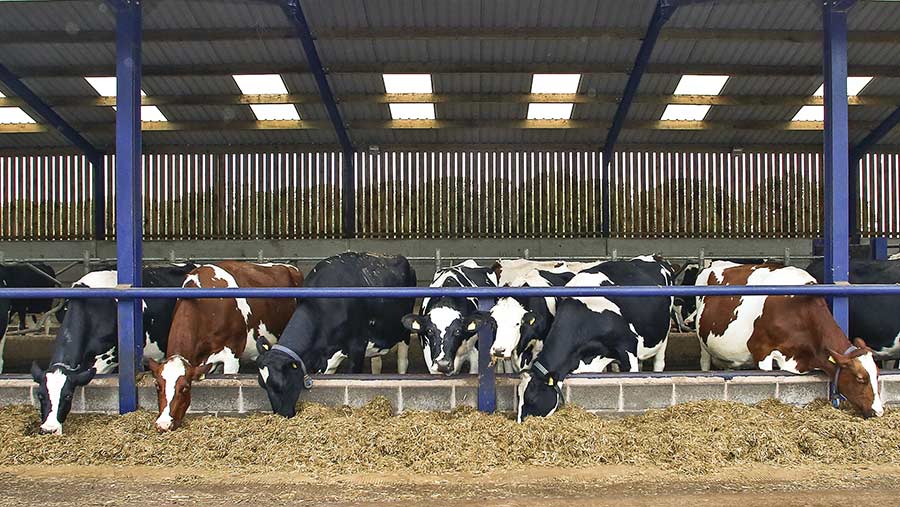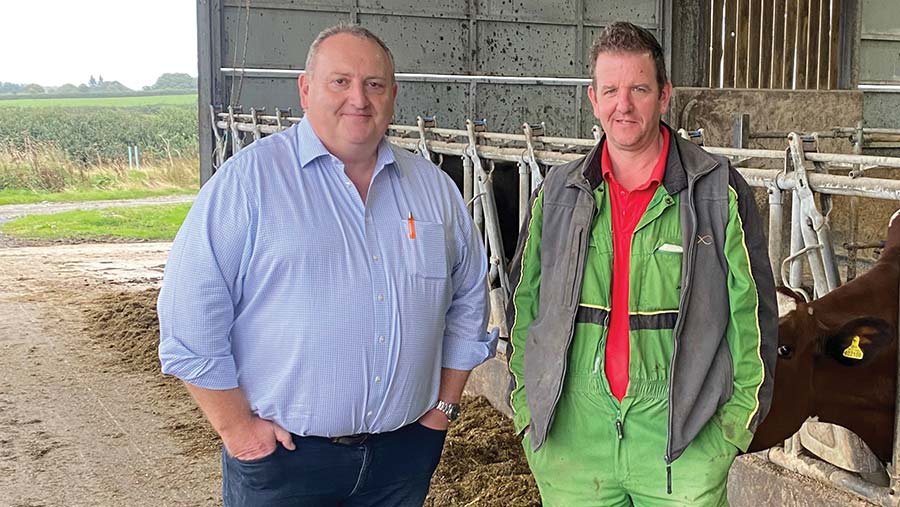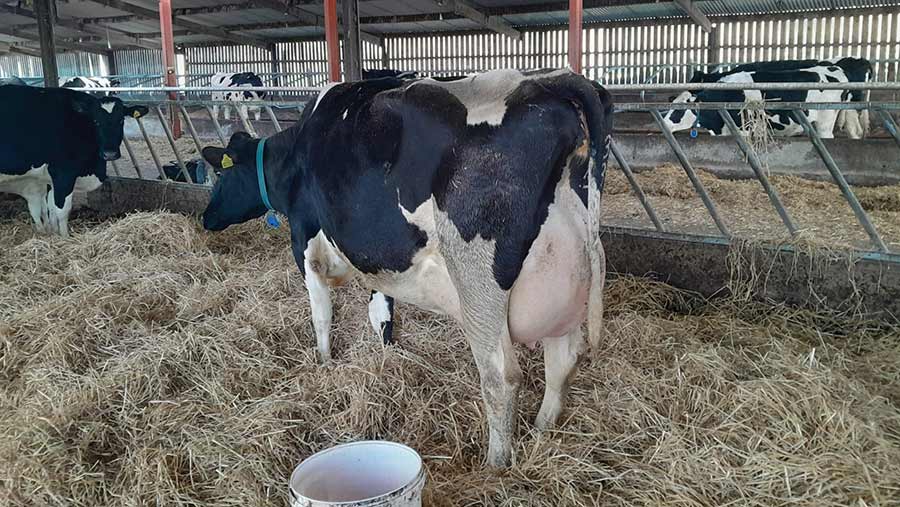Dairy transition management: Why diet is not the only focus
 © Richard Stanton
© Richard Stanton The payback on a successful transition period is “phenomenal” in terms of health, productivity and reproduction, according to Hefin Richards of Rumenation Nutrition Consultancy.
But when it is not going well, the cause is likely to be down to a range of factors.
A holistic approach is designed to find the root causes of transition issues.
These are not just about nutrition, says Hefin: “A farmer might hope to feed something to get a higher milk yield or improve fertility, but you have to dig deeper. Very often, the answer lies in transition management.”
See also: Advice on feeding calves for good rumen development
He says farmers get good and bad results with a range of feeding strategies, but a lot of the difference comes down to how well they are doing everything else.
“A range of feeding programmes, including partial or full dietary cation-anion difference [DCAD], or a calcium binder-based approach, have the potential to be very effective.
“But if you’ve got overcrowding, underlying health issues, lameness, fat cows, dirty water troughs or cows running out of feed, these will not be a silver bullet.
“You’ve got to get the whole thing right to really make it work well.”
Elements of a holistic approach
To tackle poor transition, he advises considering four areas:
- Cow factors, such as body condition, lameness and underlying health problems, will determine whether there is an increased risk of transition issues
- Nutrition at transition – is it fit for purpose? Is it well balanced? Low rumen fill pre-calving is very clearly correlated to poor milk yield post-calving
- Dry cow environment – cows are particularly susceptible to stresses caused by overcrowding, insufficient feed space or water access, poor ventilation and lack of comfort during transition
- Management – even when cow factors, nutrition and environment are optimal, if, for example, heifers are introduced too close to calving, or the calving group is mixed up every day or two, causing social turmoil, this will have a negative effect.
Reducing stress
On a lot of farms, calving takes place where it always has, usually near the parlour and the farmhouse, says Hefin.
Yet when herds get bigger, what used to be a suitable calving area becomes a bottleneck, exposing cows to a range of stresses and costing money in lost productivity.
It is becoming increasingly clear how much cows are affected by stress during the transition period, he says.
Making improvements
While putting up a new shed is a considerable investment, improvements to the dry cow environment do not have to be expensive.
“For example, one client has put four gates in the shed to make three pens of 15 rather than a yard of 45 together, to minimise mixing.”
Ventilation may be improved by replacing doors with gates to create more airflow through the shed. For units calving a lot of cows in summer, the need for good ventilation is even more critical to avoid heat stress.
If feed space is limited, and cannot be solved overnight, make sure feed is pushed up more often so cows always have access to it, Hefin advises.
Access to water can be limited by hierarchical behaviour. “Water troughs are a really good place to assert dominance, as research at the University of Guelph has shown,” he explains.
“A dominant cow will interact with every other cow in a group [at the water trough] to assert that dominance, and a timid heifer just won’t drink.
“One farmer put in ear sensor tags and CCTV and saw how much physical interaction there was [each time the calving group was mixed up].
“The tags picked up a massive amount of activity for a couple of days. He has since gone to more socially stable groups and has fewer premature calvings [as a result].”
Consistency
So much in dairy farming comes down to day-to-day management, says Hefin.
“You might have the perfect technical solution that is poorly administered, or an 80% technical solution administered consistently that will work perfectly well.
“Dry cows need guaranteed consistency seven days a week, with feed always fresh and always in reach, clean water troughs every day, and nice, big beds.”
Case study: Transition management at Newlands Farm, North Devon

Hefin Richards and David Luxton © AHDB
Farm facts
- 101ha (250 acres) owned, 28ha (70 acres) rented
- 180 pedigree Holstein Friesians
- All-year-round calving
- Fully housed system with milking robots
- Average yield 11,000 litres at 4.2% butterfat and 3.4% protein
AHDB Strategic Dairy Farmer David Luxton has been using a holistic approach to improve dry cow transition management in his housed herd of Holstein Friesians.
Working with Hefin Richards of Rumenation Nutrition Consultancy, he has made several changes at Newlands Farm, near Bude, to help him achieve better results.
Nutrition
“We’ve gone back to basics and have started feeding haylage to all the dry cows,” says David.
“This has ensured a consistency of the diet across the dry period. They then receive a dry cow nut twice a day, while the cows in the calving pens get a transition blend.”
Body condition score
David works closely with his vet to monitor body condition score (BCS) regularly across the whole herd.
This ensures any issues that might arise during the transition period can be addressed, he says.
Scoring is done at the post-calving check, pregnancy diagnosis (PD) and at dry-off, as well as other times the vet is on farm. David aims for a BCS between 2.75 and 3.5 going into the dry period.
Foot health
The fat pad in the hoof is important for maintaining foot health.
Cows will mobilise fat in early lactation, but this can be managed to avoid excessive loss of body condition, reducing the risk of lameness.
David has added maize to the milking herd diet to stimulate intakes and provide more energy to help address this.
“The maize has helped with overall lameness and condition by boosting that fat level,” he says.
“We’ve also been doing a trim 40-days post-calving on all the cows, as well as a dry-off trim, and are finding that this works well.”
Heifer management
Heifers are introduced to the dry cow group at least six weeks before they are due to calve.
“I like to give them a longer period in with the cows, so they get used to the bigger, dominant cows,” says David.
“We had one that slipped through the net; she went straight into the calving pens and then the dairy unit, and she’s not doing as well as her cohorts in the group.”
Environment
To increase feed space and give dry cows easier access to their ration, stocking density has been reduced by using former milking cow housing that was replaced by a new shed when the farm moved to milking robots.
This older shed has 52 cubicles, but is stocked at a maximum of 30-35 cows.
As a result of these changes, David has seen a noticeable reduction in metabolic disorders and transition diseases.
“There have been fewer incidences of milk fevers, with just one case in the last four months, which we can put down to a bad calving,” he says. “We’ve also had very few retained placentas.
“Milk yield is peaking quicker. Fertility has remained good, and our submission rate is 80%. Cows have got a good rumen fill and are doing really well overall.”
Case study: Transition management at Henllys Farm, Aberystwyth

© Gerald Watkin
Farm facts
- 202ha (500 acres), part owned, part rented
- 280 pedigree Holsteins
- Mainly autumn-block calving
- High yielders housed on total mixed ration; late lactation cows grazed in summer
- Average yield 9,000 litres at 4.35% butterfat and 3.45% protein
- Milk supplied on cheese contract to South Caernarfon Creameries
Dry cow accommodation had become a bottleneck at Henllys Farm, near Aberystwyth, where Gerald Watkin milks 280 pedigree Holsteins.
The small cubicle shed used for the transition period had become increasingly overcrowded as herd size grew, and a shift towards block calving had only made the situation worse.
“It was clearly having an effect on the cows – feed intakes were low, they were slow to get going after calving, and then took a long time to get back in-calf,” he says.
“We were also getting cases of milk fever and the odd left displaced abomasum [LDA].”
Action was needed, but rather than investing heavily in a new building, Gerald decided to make use of a redundant sheep shed two miles away.
“It needed a few repairs, but we thought we’d try that as we already had it.”
The long, narrow shed (55x18m) has been fitted with a total of 75 single-row, sand-bedded cubicles and two straw-bedded calving yards with a central feed passage with “bags of room” for cows to feed.
Improved feed access
The dry cows are fed a controlled-energy total mixed ration of chopped straw, grass silage, protein blend, bespoke dry cow minerals and a protected choline/methionine supplement.
“The ration hasn’t changed, it’s just that the cows had limited feed space and intakes were variable,” he says.
“The key thing is for them to be eating close to 12-13kg dry matter before calving, and with the extra feed space, they are achieving that, no problem at all.”
The layout of the shed ensures the cows can all see each other, creating a calm, relaxed environment.
“When they get close to calving, we just pop them to the other side [of the shed] and there’s no stress at all. We always give them plenty of time to calve and rarely interfere.”
As soon as they calve, cows go onto a total mixed ration.
A camera has recently been installed in the shed so Gerald can check the fresh calvers are eating, and they rejoin the milking herd 48 hours later.
More than 300 cows have now calved in the former sheep shed, and there have been no cases of milk fever or LDA among them.
“The building is nothing flash – it just shows what you can do if you’ve planned it right.”
